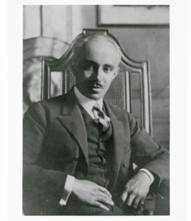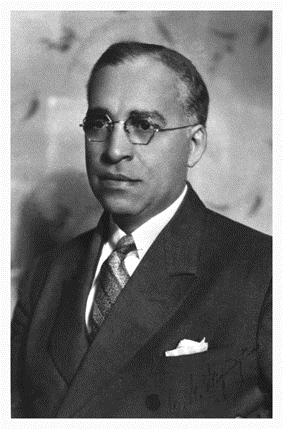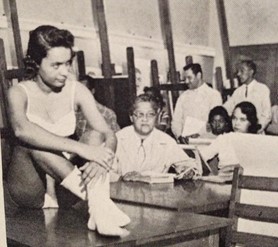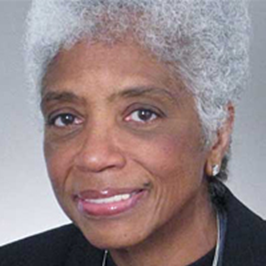
By Hannah Beitchman and Apellia Provata-Carlone
In honor of Black History Month, which runs through October, we have compiled a list of incredible black architects, who we feel should be especially highlighted during this month (and throughout the years). Many of the architects who we have mentioned today faced prejudice and racism due to being black, and therefore have not been celebrated or recognized as much as other architects and did not receive the same opportunities as their fellow white architects may have. We have listed 10 influential black architects who, we believe, should be celebrated this month.

Robert Robinson Taylor (1868-1942)
Robert Robinson Taylor was an incredible figure in history, being the first academically trained and credentialed black architect in America. He was introduced to architecture at a young age by his father, who was formerly enslaved, but then worked as a carpenter. He was the first African American student allowed into MIT, from which he graduated in 1892. While he was studying there, he met Booker T. Washington, who would continue to be a key figure over his lifetime, as he later recruited Taylor to lead the industrial program and campus expansion of Tuskegee Institute in Alabama where he then worked as vice president. Taylor designed more than two dozen buildings on its campus and was so influential to the school that the Tuskegee’s Robert R. Taylor School of Architecture and Construction Science was named after him!
Over his long career, Taylor also built many other monumental buildings, such as three colonial-style Carnegie Libraries for black colleges and designed the famed Booker T. Washington Agricultural and Industrial Institute in Liberia.

Moses McKissack III (1879–1952)
Moses McKissack III, was born in Tennessee, where from a young age he would work with his father in building, carpentry, and in the contracting business which was a longstanding family tradition – his grandfather, an African-born enslaved person, was a trained builder. Moses McKissack III was one half of the brother duo which formed McKissack and McKissack, the nation’s first black-owned architecture firm, and the oldest to still continue to be in operation today. In their early years, Moses McKissack produced many designs: residences, churches, public schools and housing, before 1942, where they won a multi-million dollar federal contract to design the Tuskegee Army Airfield. At the time, this was the largest project ever to be awarded to a black-owned firm.
Today the firm still goes on, and is known for its design and construction management, and one of its more recent and notable projects was the National Museum of African American History and Culture, designed by architect David Adjaye, who we will mention more on later…

Julian Abele has an incredibly rich legacy but is one that unfortunately went unrecognized for many years. He was a modest man and the firm he worked for had a policy in which there was a lack of individual signatures of blueprints and plans, making it difficult for historians to know the full extent of his work – even after he became co-leader of the firm in 1938. He was the chief designer for Horace Trumbauer, who was an important Gilded Age architect, and produced many decades of skilled design – including the Philadelphia Free Library and Museum of Art, mansions in Newport and Harvard’s Widener Library.
He also went unrecognized for many years, due to the racism of Duke University which wouldn’t allow African American students to graduate from there until 1961, even though a huge number of those buildings were designed by Abele. He designed over 30 of the buildings! This includes its chapel, library, stadium, medical school and hospital. Only in 2016 was Abele recognized for his work, when the school named the area encompassing those original academic and residential buildings the Abele Quad.

Clarence Wesley “Cap” Wigington (1883–1967)
Clarence Wesley “Cap” Wigington, was the first registered black architect in Minnesota and the first black municipal architect in America.
He grew up in Omaha and as a teenager he made his artistic skills clear when he won prizes for drawings and sketches at the 1898 Trans-Mississippi Exposition. He would eventually apprentice under Thomas Kimball, who was a renowned local architect and the future president of AIA. He opened his own practice in Omaha, but after finding the racial resentment too strong, he moved to Minnesota.
In Minnesota, his work helped to create the ‘look’ of the city which is still influential to this day. Wigington created an extensive body of Civic work for St. Paul, Minnesota – 60 of his buildings are still standing! At the time he created firehouses, schools, golf clubhouses, airports and even the temporary ice palaces and the architectural ice carvings for the city’s Winter festival. These were so incredible, Wigington became famous for them.
His pavilion on the Mississippi River, the Harriet Island Pavilion, 1941, is particularly influential and earned listings on the National Register of Historic Places. Later in 1998, it became renamed the Clarence W. Wigington Pavilion.

Amaza Lee Meredith (August 14, 1895 – 1984)
Amaza Lee Meredith was an American architect, educator, and artist. Unfortunately, Meredith faced prejudice in many directions – she was unable to enter the profession as an architect due to both her race and her sex. Therefore, she primarily worked as an art teacher at Virginia State University where she founded the art department.
She is best known for her residence, Azurest South which is located on the campus of Virginia State University and is of the Post World War I German: International Style. Here she resided with her partner, Edna Meade Colson. Despite not being able to become a formal architect, she continued to pursue her passion, designing many homes for her family and friends in Virginia, New York and Texas. In 1947, she began to develop a 120 subdivision in Sag Harbor which was called Azurest North, and her and friends created a group called the Azurest Syndicate which would work to create this space for an African American leisure community. Lots were sold to investors who built cottages there and the Terry Cottage and Edendot were both designed by Meredith.
Although she never gained recognition for her work as an architect she continued to design buildings and create artwork – she received patent for an accessory to be attached to a golf bag, designed logos to be used for a proposed name change for the NAACP and did much more.

Beverly Loraine Greene (1915–1957)
Beverly Loraine Greene is believed to be the first licensed African-American female architect in the US. In 1937, she earned a Bachelor’s degree in architectural engineering, again, making her the first African-American woman to compete this degree at the University of Illinois. After facing racial prejudice working as an architect with the Chicago Housing Authority, and with her work largely being ignored by the Chicago Press, she went on to work in New York on a housing project in Manhattan.
Greene continued her successful career, working in healthcare and hospital design with people such as Isadore Rosenfield, but also internationally, helping to build the UNESCO United Nations headquarters in Paris. Sadly, she died at the age of 41, before the completion of her last project: designing buildings for New York University, however, the legacy she left behind helped greatly to inspire future generations.

Georgia Louis Brown Harris carried on the legacy left behind by Beverly Loraine Greene, becoming the second African American woman licensed as an architect in the US. After graduating as one of the top students from her high school, she went on to study at Washburn University. After graduating, she moved to Chicago, where she found her love for aviation, as well as studying architecture at the Illinois Institute of Technology. Throughout her career, she frequently faced not only racial prejudice, but also gender inequality. This led to her divorce in 1953 from James Brown, when she found that she was unable to reconcile her career and her marriage.
She continued an impressive career in Brazil from the 1940s, becoming an influential part of the architectural industry, however, her work was often uncredited, and publications of her work frequently cited the engineering firms involved instead of her.

Norma Sklarek (1926–2012)
Born in New York, Sklarek became the first African American woman to graduate with a degree in architecture from Columbia University in 1950. She went on to work as a Junior Draughtsman in the Department of Public Works until 1954. After having applied to 20 different architectural firms, and now having a license to practice architecture, she found a job at Skidmore, Owings and Merrill. In the meantime, she was teaching evening classes in architecture at New York City Community College, while also raising her two children as a single mother.
In 1960, Sklarek moved to California to work for Gruen Associates, eventually becoming their first African American female director. She collaborated on many projects, not least the Embassy of the United States in Tokyo (in 1976), however, she struggled to gain the recognition that she deserved, with most of her work being credited to other architects, and frequently being classified as project manager rather than a designer.

Allison Williams
Allison Williams’ projects are characterized by the emphasis she places on the issues we face today; be that environmental concern and sustainability or ensuring social justice through her work. In 2017, she established AGWms_studio, working on projects such as the Princess Nora University for Women, as well as Measurement Sciences Laboratory at NASA’s Langley Research Center. Now a lecturer at Stanford University, Williams continues to spread her ideas for innovation and building a positive future.
In 2018, Williams was awarded the Norma Sklarek Award in Architecture, which goes to show what a long-lasting impact each of these women have had in inspiring others and fueling the future of architecture.

Sir David Adjaye (1966 – present)
An award-winning Ghanian-British architect, Sir David Adjaye was born in 1966 in Dar es Salaam, Tanzania. His father being a diplomat, Adjaye was frequently travelling as a child, this helped to form one of his early projects ‘Adjaye Africa Architecture: A Photographic Survey of Metropolitan Architecture’, a project that evolved over 10 years, documenting 54 major African cities, and re-establishing what defined African architecture.
In 2000, he founded his practice Adjaye Associates which has now spread globally. One of his most notable works is the National Museum of African American History & Culture in Washington built in 2016. Adjaye was knighted in 2017 for services to architecture.